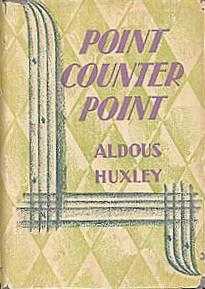Point Counter Point

Point Counter Point is a novel by Aldous Huxley, first published in 1928. It is Huxley's longest novel, and was notably more complex and serious than his earlier fiction.
In 1998, the Modern Library ranked Point Counter Point 44th on its list of the 100 best English-language novels of the 20th century.
Title and construction
The novel's title is a reference to the musical technique of counterpoint, and the story is constructed after the fashion of a work of music. Instead of a single central plot, there are a number of interlinked storylines and recurring themes. Many of the characters are based on real people, most of whom Huxley knew personally.
Main characters and storylines
Some of the main characters include:
- Walter Bidlake, a young journalist. A weak and ineffectual man, Walter is living with Marjorie Carling, a married woman whose husband refuses to grant her a divorce. Marjorie is pregnant with Walter's child, but their relationship is disintegrating, largely because Walter has fallen desperately in love with the sexually aggressive and independent Lucy Tantamount (based on Nancy Cunard, with whom Huxley had a similarly unsatisfactory affair).
- John Bidlake, Walter's father, a painter (based on Augustus John). He is famous for his work and for his scandalous love life. However, his recent paintings show a creative decline, which he himself recognises but refuses to admit. He has an illness which is eventually diagnosed as terminal cancer.
- Philip Quarles, a writer (a self-portrait of Huxley) and his wife Elinor, John Bidlake's daughter. They return from India to England. Quarles is a withdrawn, cerebral man, ill at ease with the everyday world and its emotions; Elinor loves him, but is tempted to enter into an affair with the bold and attractive Everard Webley, a political demagogue and leader of his own quasi-military group, the Brotherhood of British Freemen. (Webley is often assumed to be based on Oswald Mosley, but there are reasons for doubting this: see below.) Quarles' father, Sidney, is unlike his son: outwardly impressive, he is in reality pretentious, feeble and self-indulgent. An undistinguished MP and failed businessman, he has retired from public life, supposedly to concentrate on writing a vast and definitive study of democracy. In fact he has written nothing, but he employs a secretary; the girl becomes pregnant by him and threatens to make a scandal. Philip and Elinor have a young son, little Phil, who becomes ill and dies of meningitis.
- Mark Rampion, a writer and painter. Based on D. H. Lawrence, whom Huxley admired greatly, Rampion is a fierce critic of modern society. A full chapter in flashback shows Rampion's courtship and marriage to his wife, Mary (based on Lawrence's wife Frieda).
- Maurice Spandrell, an intellectual without purpose or faith (based on Charles Baudelaire, who of course did not live in Huxley's time). For years Spandrell has devoted himself to vice and deliberate wickedness. He has found some pleasure in the corruption of an innocent young girl, both in the act itself and in his own feelings of remorse. (The novel gives only vague hints as to what he has actually done to the girl.) More than anything else, however, he suffers from ennui, the sense that everything is pointless. He meets Illidge, a young scientist of working-class origin, and taunts him for his angry left-wing rhetoric and actual political impotence; eventually they join together and succeed in murdering Everard Webley. The murder achieves nothing, except to strengthen Webley's Brotherhood of British Freemen. Spandrell sends an anonymous note to the Brotherhood, informing them that the murderer is at his address; when they arrive he allows himself to be shot and killed, while the third movement from Beethoven's String Quartet No. 15 plays in the background.
- Denis Burlap, Walter Bidlake's editor. Based on John Middleton Murry, Burlap is in his writings and public image a Christian and an anguished, self-accusing moralist; in his inner thoughts and private behaviour, however, he is calculating, avaricious and libidinous. He lives with Beatrice Gilray (based on Dorothy Brett, painter), who at thirty-five remains a virgin, having been molested as a young girl; for some time their relationship is platonic, but Burlap succeeds in seducing her. The novel ends with his having secured several thousand dollars for a book, St Francis and the Modern Psyche, and enjoying an evening of sensual pleasure with Beatrice.
Oswald Mosley comparison
Comparisons have been made between the character Everard Webley and his Brotherhood of British Freemen and Oswald Mosley and the British Union of Fascists. However, when Huxley wrote Point Counter Point Mosley was still a prominent member of the Labour Party, and would remain so until 1931; the BUF was not founded until 1932. A number of other fascist groups preceded Mosley, the most prominent being the British Fascists, and possibly one of those may have been Huxley's inspiration. In the 1996 reprint of Point Counter Point, Mosley's son Nicholas discusses the connection in a new introduction to the novel. David Bradshaw has argued that the most likely source for Webley is John Gordon Hargrave, founder of The Kindred of the Kibbo Kift.[1]
Film and television adaptations
The novel was adapted into a BBC mini-series by Simon Raven in 1968, starring Tristram Jellinek. It was later broadcast on PBS television in 1972.
References
- ↑ Bradshaw, David (2002). "Huxley's 'Tinpot Mussolini' and the KKK's 'White Fox': A New Source for Everard Webley and the Brotherhood of British Freemen in 'Point Counter Point'". Aldous Huxley Annual 2: 146–59.
External links
- Somaweb.org – a collection of links relating to Huxley's works in general
- Point Counter Point at the Internet Movie Database
| |||||||||||||||||||||||||||||||||||